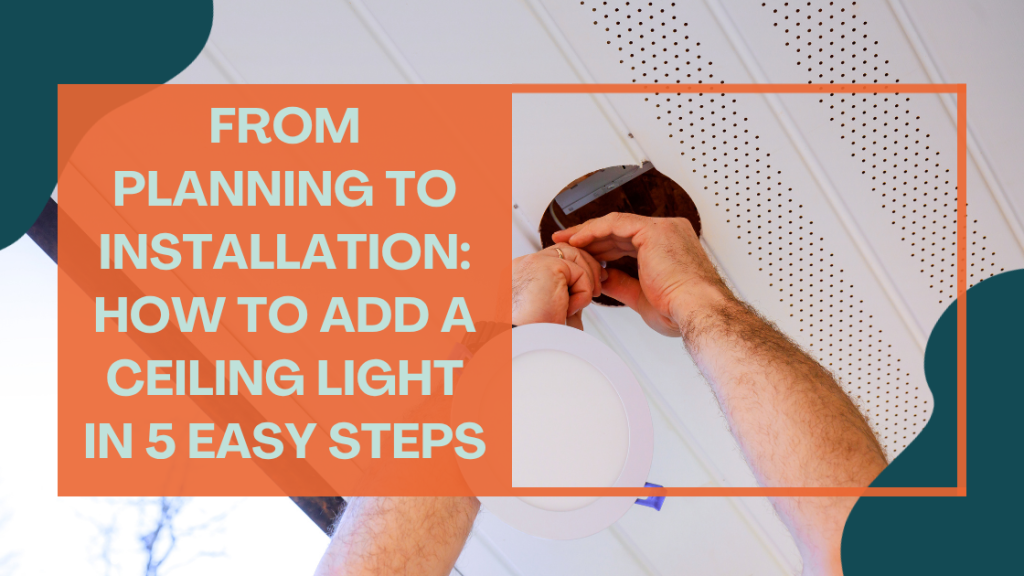Adding a ceiling light can instantly change the look and feel of a room. Whether you’re tired of that dim corner in your living room or want to brighten up your kitchen, learning how to install ceiling light fixtures is a great way to bring fresh energy into your home. It might sound like a big project, but with a little planning and some basic tools, it’s something any homeowner can handle. And if you’d rather skip the wiring stress, you can always count on Light Fixture Installation experts to handle everything safely and efficiently.
Step 1: Plan Where and Why You Want the Light
Before you start drilling or touching wires, think about where the new light should go. Planning is the key to a clean and balanced design. Ask yourself what you’re lighting: a dining table, a reading area, or a whole room? The placement of the light makes a huge difference.
If you’re wondering how to add a ceiling light to a room that doesn’t already have one, consider where your electrical lines run. You might need to tap into an existing circuit or run a new one. If you’re not sure, a licensed electrician or Light Fixture Installation service can check your wiring and suggest the safest setup.
Step 2: Turn Off Power and Get the Right Tools
This step is all about safety. Always turn off power from your circuit breaker before touching anything electrical. Don’t just flip the wall switch: shut it off from the breaker box to be sure. Use a voltage tester to confirm there’s no power running to the wires before you start.
For installing ceiling light fixture projects, gather your tools: a screwdriver, wire stripper, ladder, drill, pliers, and maybe a voltage tester. Having everything ready saves time and helps you stay focused once you start.
Step 3: Remove the Old Fixture or Prepare for a New One
If you already have a light fixture, carefully remove it by unscrewing the base and disconnecting the wires. Keep note of which wire connects where: usually black to black (hot), white to white (neutral), and the copper or green wire to ground. If you’re starting from scratch, you’ll need to install a ceiling electrical box that can safely hold the fixture’s weight.
This is where people often get stuck when figuring out how to install ceiling light setups in older homes. Some ceilings don’t have a junction box at all, so you might need to cut a small hole and add one. Make sure it’s securely attached to a ceiling joist or use a support brace if it’s heavy, especially for chandeliers or pendant lights.
Step 4: Connect the Wires and Mount the Fixture
Once your box is ready, it’s time for the main event. Connect the wires: black to black, white to white, and ground to ground. Twist them together tightly using wire nuts, then tuck them neatly into the electrical box. It’s important to double-check each connection before moving on.
After wiring, mount your fixture base to the box using the included screws. Once it’s secure, attach the rest of your light, such as shades or bulbs. This part can vary depending on the type of fixture you’re working with, but most installing ceiling light fixture kits come with clear instructions and mounting hardware.
Step 5: Turn the Power Back On and Test
Now comes the best part; seeing your work light up! Turn the power back on at the breaker and flip the wall switch. If everything works, great job! If not, double-check your connections or call a professional for help. Sometimes, a tripped breaker or loose wire is all that’s standing between you and success.
Once it’s working, tidy up the area. Replace any ceiling plates, clean the light fixture, and admire how much brighter your room looks. Adding even one well-placed ceiling light can make your space feel bigger, warmer, and more inviting.
Pro Tips for a Smooth Ceiling Light Installation
Even though it’s tempting to rush the process, take your time. Rushing can lead to wiring mistakes or crooked installations. For anyone who is new to electrical work, calling a Light Fixture Installation service might be the safer choice. Professionals have the right tools, know how to handle complex wiring, and can make sure your installation meets safety codes.
When planning how to add a ceiling light, consider energy efficiency. LED bulbs last longer and use less power than traditional bulbs. You can also choose dimmable lights for flexibility in brightness. If you’re installing multiple fixtures, smart lighting systems are worth exploring: they let you control everything with your phone or voice commands.
Another detail people often overlook is fixture size. A fixture that’s too small can look out of place, while one that’s too big can overwhelm the room. As a general rule, add the length and width of your room (in feet) and use that number (in inches) as a guide for the fixture’s diameter. For example, a 12-by-10-foot room should have a light around 22 inches wide.
When to Call the Pros
Even if you love DIY projects, electrical work can be tricky. If you’re dealing with old wiring, no ceiling box, or adding multiple fixtures, it’s usually best to get help from professionals who handle this every day. A licensed Light Fixture Installation expert can ensure your setup is safe, efficient, and built to last.
They can also suggest lighting layouts and fixture styles that complement your home’s design. So instead of worrying about connecting wires or finding the right support, you can sit back and enjoy your beautifully lit space.
Final Thoughts
Learning how to install ceiling light fixtures gives you the satisfaction of upgrading your space on your own. It’s one of those projects that instantly transforms a room, making it brighter and more welcoming. But remember, safety always comes first. If you’re ever unsure about the wiring or placement, don’t hesitate to bring in experts who know exactly how to handle it. With the right tools, planning, and maybe a little professional help from Light Fixture Installation specialists, your home can look amazing in just a few hours. So grab your ladder, switch off that breaker, and get ready to bring a little more light into your world.



